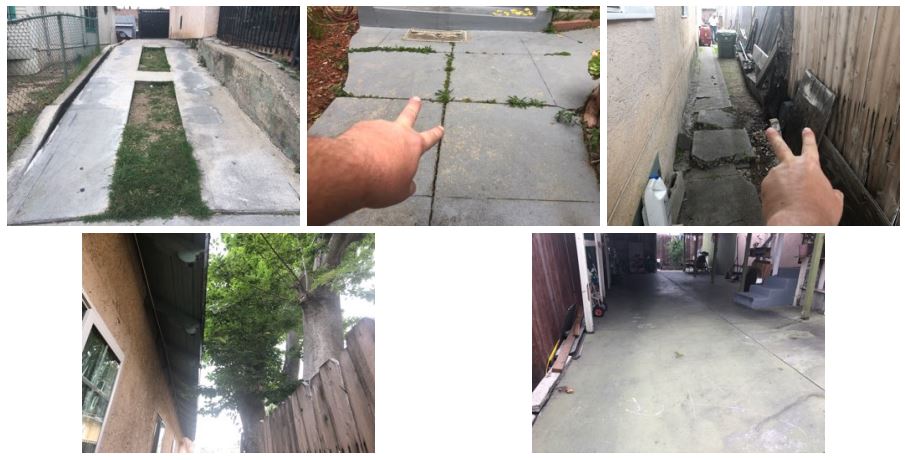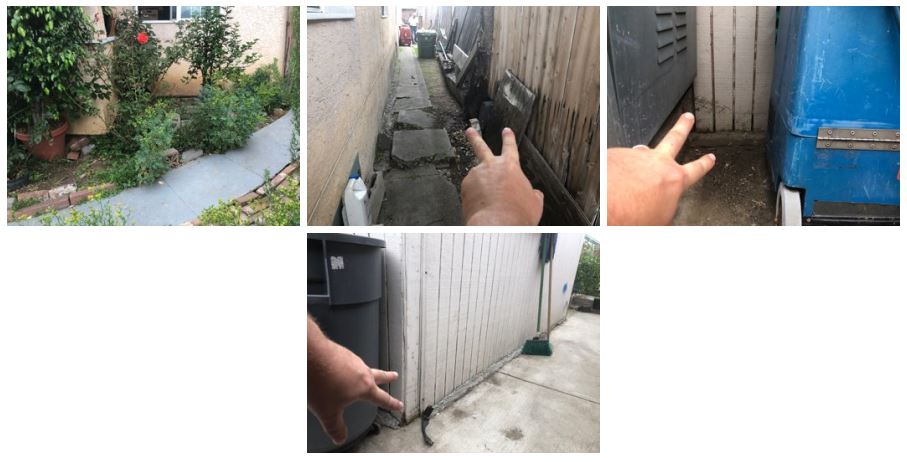Home Inspection- Corona
2160 Georgetown Dr, Corona, CA 92881
Inspection prepared for: David Dopson
Real Estate Agent: Susan Milhaupt –
Date of Inspection: 11/14/2019 Time: 4:30 PM
Age of Home: 1993 Size: 1506 sq. Feet
Weather: Clear
Order ID: 66
Inspector: Clark Gerdes
Certified CREIA Inspector #166834
17130 Van Buren Blvd., #200, Riverside, CA 92504
The Home Inspector Shall Observe The Following:
Exterior: Wall cladding, flashings, and trim; Entryway doors and a representative number of windows; Garage door
operators; Decks, balconies, stoops, steps, areaways, porches and applicable railings; Eaves, soffits, and fascias; and
Vegetation, grading, drainage, driveways, patios, walkways, and retaining walls with respect to their effect on the
condition of the building. The home inspector shall: Describe wall cladding materials; Operate all entryway doors and a
representative number of windows; Operate garage doors manually or by using permanently installed controls for any
garage door operator; Report whether or not any garage door operator will automatically reverse or stop when meeting
reasonable resistance during closing; and Probe exterior wood components where deterioration is suspected. The home
inspector is not required to observe: Storm windows, storm doors, screening, shutters, awnings, and similar seasonal
accessories; Fences; Presence of safety glazing in doors and windows; Garage door operator remote control
transmitters; Geological conditions; Soil conditions; Recreational facilities (including spas, saunas, steam baths,
swimming pools, tennis courts, playground equipment, and other exercise, entertainment, or athletic facilities); Detached
buildings or structures; or Presence or condition of buried fuel storage tanks. The home inspector is not required to:
Move personal items, panels, furniture, equipment, plant life, soil, snow, ice or debris that obstructs access or visibility.
Gutters and subsurface drains are not water tested for leakage, blockage.
Plumbing: Interior water supply and distribution system, including: piping materials, supports, and insulation; fixtures and
faucets; functional flow; leaks; and cross connections; Interior drain, waste, and vent system, including: traps; drain,
waste, and vent piping; piping supports and pipe insulation; leaks; and functional drainage; Hot water systems including:
water heating equipment; normal operating controls; automatic safety controls; and chimneys, flues, and vents; supply
piping, venting, and supports; leaks. The home inspector shall describe: Water supply and distribution piping materials;
Drain, waste, and vent piping materials; Water heating equipment; and Location of main water supply shutoff device. The
home inspector shall operate all plumbing fixtures, including their faucets and all exterior faucets attached to the house,
except where the flow end of the faucet is connected to an appliance. The home inspector is not required to: State the
effectiveness of anti-siphon devices; Determine whether water supply and waste disposal systems are public or private;
Operate automatic safety controls; Operate any valve except water closet flush valves, fixture faucets, and hose faucets;
Observe: Water conditioning systems; Fire and lawn sprinkler systems; On-site water supply quantity and quality; On-site
waste disposal systems; Foundation irrigation systems; Spas, except as to functional flow and functional drainage;
Swimming pools; Solar water heating equipment; or Observe the system for proper sizing, design, or use of proper
materials.

Electrical: Service entrance conductors; Service equipment, grounding equipment, main over current device, and main
and distribution panels; Amperage and voltage ratings of the service; Branch circuit conductors, their over current
devices, and the compatibility of their ampacities and voltages; The operation of a representative number of installed
ceiling fans, lighting fixtures, switches and receptacles located inside the house, garage, and on the dwelling’s exterior
walls; The polarity and grounding of all receptacles within six feet of interior plumbing fixtures, and all receptacles in the
garage or carport, and on the exterior of inspected structures; The operation of ground fault circuit interrupters; and
Smoke detectors. The home inspector shall describe: Service amperage and voltage; Service entry conductor materials;
Service type as being overhead or underground; and Location of main and distribution panels. The home inspector shall
report any observed aluminum branch circuit wiring. The home inspector shall report on presence or absence of smoke
detectors, and operate their test function, if accessible, except when detectors are part of a central system. The home
inspector is not required to: Insert any tool, probe, or testing device inside the panels; Test or operate any over current
device except ground fault circuit interrupters; Dismantle any electrical device or control other than to remove the covers
of the main and auxiliary distribution panels; or
Observe: Low voltage systems; Security system devices, heat detectors,
or carbon monoxide detectors; Telephone, security, cable TV, intercom, or other ancillary wiring that is not a part of the
primary electrical distribution system; or Built-in vacuum equipment.
Heating System: Heating equipment; Normal operating controls; Automatic safety controls; Chimneys, flues, and vents, where readily visible; Solid fuel heating devices; Heat distribution systems including fans, pumps, ducts and piping, with
supports, insulation, air filters, registers, radiators, fan coil units, convectors; and the presence of an installed heat source
in each room. The home inspector shall describe: Energy source; and Heating equipment and distribution type. The
home inspector shall operate the systems using normal operating controls. The home inspector shall open readily
openable access panels provided by the manufacturer or installer for routine homeowner maintenance. The home
inspector is not required to: Operate heating systems when weather conditions or other circumstances may cause
equipment damage; Operate automatic safety controls; Ignite or extinguish solid fuel fires; or Observe: The interior of
flues; Fireplace insert flue connections; Humidifiers; Electronic air filters; or The uniformity or adequacy of heat supply to the various rooms. Extinguished pilot lights are not lit by the Inspector.

Roofing: Roof covering; Roof drainage systems; Flashings; Skylights, chimneys, and roof penetrations; and Signs of’
leaks or abnormal condensation on building components. The home inspector shall: Describe the type of roof covering
materials; and Report the methods used to observe the roofing. The home inspector is not required to: Walk on the
roofing; or Observe attached accessories including but not limited to solar systems, antennae, and lightning arrestors.
While the inspector makes every effort to find all areas of concern, some areas can go unnoticed. Roof coverings and
skylights can appear to be leak proof during inspection and weather conditions. Our inspection makes an attempt to find
a leak but sometimes cannot. Please be aware that the inspector has your best interest in mind. Any repair items
mentioned in this report should be considered before purchase.
It is recommended that qualified contractors be used in
your further inspection or repair issues as it relates to the comments in this inspection report.
This report is an opinion of the general quality and condition of the roof.
The Inspector can not, and does not offer an opinion as to whether the roof
has leaked in the past or is subject to future leaks.
Interior: Walls, ceiling, and floors; Steps, stairways, balconies, and railings; Counters and a representative number of
installed cabinets; and A representative number of doors and windows. The home inspector shall: Operate a
representative number of windows and interior doors; and Report signs of abnormal or harmful water penetration into the
building or signs of abnormal or harmful condensation on building components. The home inspector is not required to
observe: Paint, wallpaper, and other finish treatments on the interior walls, ceilings, and floors; Carpeting; or Draperies,
blinds, or other window treatments.
Mold Evaluation: This is not a Mold or Fungus inspection. It is advised to have a Mold specialist examine the property
and structure and do a complete inspection to determine the presence or absence of any Mold that may affect the health
or safety of the occupants. It is typical when a building is remodeled or repairs are undertaken that additional problems
may surface that were not noted on the inspection report. This is to be expected as walls, floors and ceilings are opened
up during the work/remodel to reveal areas that were not accessible during the inspection. Any remodeling work
undertaken on property should be expected to reveal some possible hidden issues and it is recommended that additional
sums be set aside for this purpose.
Bathrooms:
Bathroom functions of the following bathroom fixtures: sinks, faucets, drains, toilets, tubs,
showers, exhaust fans and heaters, wall ceiling lights and GFCI outlets
Kitchen:
Permanently installed dishwasher, through its normal cycle; Range, cook top, and permanently installed oven;
Trash compactor; Garbage disposal; Ventilation equipment or range hood; and Permanently installed microwave oven.
The home inspector is not required to observe: Clocks, timers, self-cleaning oven function, or thermostats for calibration
or automatic operation; Non built-in appliances; or Refrigeration units. The home inspector is not required to operate:
Appliances in use; or Any appliance that is shut down or otherwise inoperable.
Foundation: Observe structural components including foundations, floors, walls, columns or piers, ceilings and roof. The
home inspector shall describe the type of Foundation, floor structure, wall structure, columns or piers, ceiling structure,
roof structure. The home inspector shall enter under floor crawl spaces, basements, and attic spaces except when
access is obstructed, when entry could damage the property, or when dangerous or adverse situations are suspected;
Report the methods used to observe under floor crawl spaces and attics; and Report signs of abnormal or harmful water
penetration into the building or signs of abnormal or harmful condensation on building components. The home inspector
is not required to: Enter any area or perform any procedure that may damage the property or its components or be
dangerous to or adversely effect the health of the home inspector or other persons.

